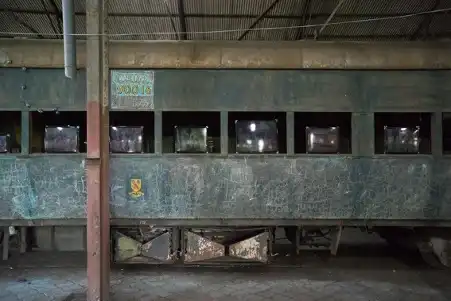
Mawuenya Amudzi, Blueprint I and Blueprint II, detail, Eva Maria Ocherbauer 2017.
Born Accra, Ghana (1992), lives and works in Kumasi, Ghana
Blueprint I 2017
photograph, disused cathode ray computer monitors and television sets, metallic bolt, nuts, cable belts
Blueprint II 2017
photograph, disused cathode ray television sets
Courtesy of the artist
Artist’s statement
Blueprint I
Objects have the potential to live second or even third lives if we enable them to. In my experiments, I test these thoughts. By joining various odd objects together, new lively worlds come to light. This is what excites me. I’m always looking forward to a pleasant surprise whenever I set about a project.
I use photography as a tool to capture some of the daily realities of certain classes of people in cities. By employing various transfer techniques, I simulate the original functions of disused cathode ray tube computer monitors and television sets. The images may be re-touched or taken through many forms of manipulation before being printed on transparent stickers and pasted on the screens. This gesture engages subtly with the nostalgia of watching static images displayed on actual cathode ray television sets.
Blueprint I is part of a series of objects I am creating as social monuments. It is made up of six layers of disused cathode ray television sets, stripped of their erstwhile bodies. Each layer is made up of four screens. The four screens are joined together using metallic bolt and nuts and cable belts. The form of Blueprint I alludes in a slight sense, to the pyramid as an archetypal building structure. The images on the screens are portraits of scrap site workers and the activities they engage in. These objects and installations created with the residue of domestic entertainment and official occupation could bear witness to the excesses of contemporary society, offering a critique of the let-downs of social, political and economic policies.
Blueprint II
Blueprint II is part of a series of objects I am creating as social monuments. It’s made up of ten disused cathode ray television sets, stripped of their erstwhile bodies. Each screen occupies windows of the deserted train within the exhibition space. I employ these window spaces as frames for the pieces which initiates interesting dialogues. This mode of display metaphorically plays on the idea of seeing, watching …
The images on the screens are portraits of scrap site workers, “mates” (bus conductors) and activities they engage in. These objects and installations created with the residue of domestic entertainment and official occupation could bear witness to the excesses of contemporary society, making a critique on the let-downs of the social, political and economic policies.









